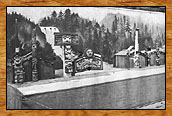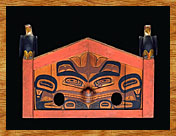(Page 2 of 2)
 Housefront Housefront
 Paintings Paintings
 Carved Interior Carved Interior
 Poles and Posts Poles and Posts
 Interior Screens, Interior Screens,
 Housepits, and Housepits, and
 Smokeholes Smokeholes
 |
Housefront Paintings
There is evidence of two other painted housefronts in Skidegate village proper. The first belonged to the town chief, Skidegate, whom collector James G. Swan referred to as "Skidegate the Great," the highest-ranking chief on the central and southern islands and equal in rank to Chief Wiah of Masset. We know of this housefront painting only from a model, which probably exaggerates reality. The model depicts a Konankada flat design, almost identical to that on many carved storage chests. There are no flanking bird or animal figures as in the Tsimshian examples, but Killer Whale designs are painted on the side walls of the model. In concept, this design is comparable to the Tsimshian housefront painting from Fort Simpson now in the Smithsonian Museum. This assemblage has been interpreted as the Tsimshian figure Hakulack, a variant of Gonankadet (or Konankada), flanked by two Killer Whales.
Although nothing has survived of the housefront painting owned by Chief Skidegate, historical photos of his house reveal that it had no frontal pole (although that of his predecessor stood nearby). The housefront was an unusually plain one for such a high-ranking chief, and the implication is that it was decorated for potlatches by the erection of a painted plank housefront screen -- and possibly additional painted screens on the sides of the house -- as shown on the Field Museum model of the village.

 |
This model of Skidegate village was commissioned for the Columbian World Exposition in Chicago in 1893. James Deans hired most of the artists active in Skidegate at the time to make models of their own lineage houses. |

The second Skidegate decorated housefront is considerably different. Grizzly Bear's Mouth House, owned by Chief Giatlins, was a six-beam structure in which the decoration was both carved and painted onto the thick vertical planks that were inserted into the gables of the housefront. Although this housefront technically was removable, it was so integrated into the structure that it was probably left in place permanently.

 |
This is a model of Chief Giatlins's Grizzly Bear's Mouth House, one of the most unusual buildings in Skidegate. The housefront was sculpted as well as painted, particularly the snout of the Bear, which protruded several feet from the painted portion. Two oval doorways were positioned at the corners of the Bear's mouth. The Eagles on the corner posts are crests that belong to the owner's wife. The model was made about 1890 by John Robson, a leading Skidegate carver who inherited the house.
Acquired at Skidegate before 1900 for the Lord Bossom collection.
CMC VII-B-1556 (S92-4309) |

Skidegate artist John Robson (a later Chief Giatlins) made two models of Grizzly Bear's Mouth House that survive, one in the Canadian Museum of Civilization and the other in the Field Museum. The former coincides closely with the photo of the house taken in 1878 by George M. Dawson, who was sent by the federal government to survey the central and northern coast of British Columbia in the late 1870s. A memorial pole in front of this house was commissioned by John Robson in memory of his wife Qwa'Kuna, the mother of Charles Edenshaw.
There are no known housefront paintings among the Kaigani Haida of Alaska, with the exception of the funeral monument at Howkan. However, there are some Kaigani house models with painted front panels as well as totem poles. No historical photo confirms this combination, so the models may have been made more for tourist appeal than as an authentic record. One house model acquired by the collector Lord Bossom has on it every possible decoration.

 |
House models were a favourite souvenir of early tourists, and Haida carvers embellished them with every conceivable decoration. This one made by a Kaigani Haida artist in the 1890s has carved frontal and corner poles, carved rafter ends and even a housefront painting of a Raven in opposing profiles. No such house was ever built.
Acquired in southeast Alaska before 1900 by George T. Emmons for the Lord Bossom collection.
CMC VII-X-1280 (S94-6741) |

|